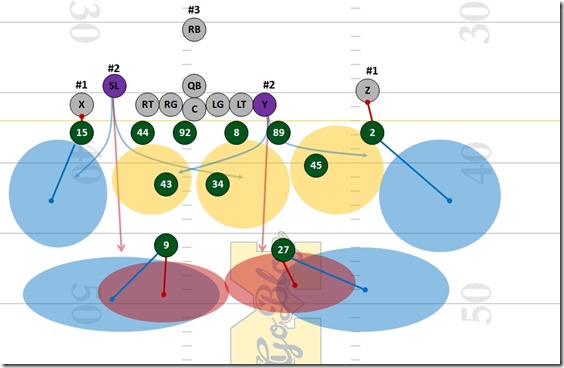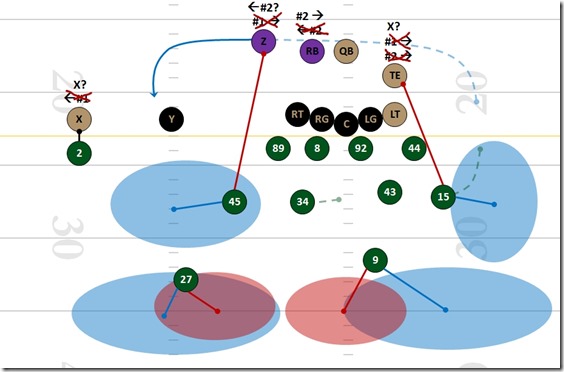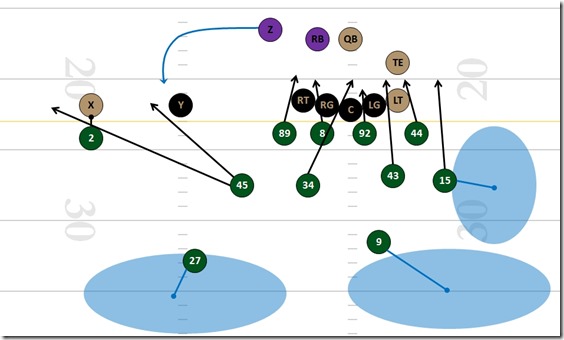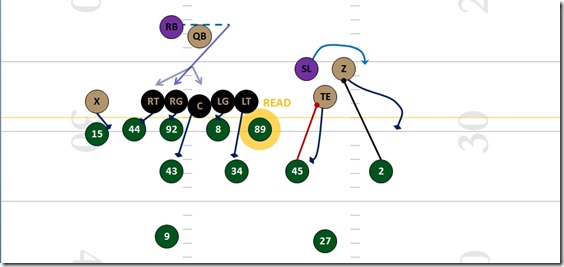Hokepoints Seeks Hope in Hazell

I know Hoke said they spent the bye week on Michigan's "identity," by which we're pretty sure he meant scrapping any semblance of sense again in favor of slamming fullbacks into people and praying for the turnover fairy to stop hating us. But for those people actually interested in how to defeat Michigan State's lauded/loathed defense, it appears to be vulnerable when you spread 'em out and test them deep.
Quarters redux
You should remember how their thing works. The defensive backs read the inside (#2) receiver; if that guy goes vertical the DBs play cover 4; if that guy goes horizontal they play Cover 2.
Red: #2 receiver goes vertical. Blue: #2 receiver doesn't go vertical
With that many guys reading, the defense can play "9 in the box," by which they mean the safeties are part of the run fits. Their run D is gap-oriented.
Just an example. They change up who's got what
Note that screens and such are treated as runs.
[After the jump: tripping them up.]
You confuse these simple reads by putting three deep threats on the same side, and sacrificing your self-respect and manliness by spreading them out.
Note that the boundary cornerback, #15, now has a read on the other side of the formation. In practice, he'll play man to man on his guy (zone life on the boundary is like that anyway) and the safety will call out whether he's got help over the top (i.e. Cov 2) or no.
Doing this can get confusing, though. What if the slot receiver motions from the backside to the hash at full speed right before the snap? Is everyone going to recalibrate their reads that fast? What if the slot is right behind the Y receiver when it's snapped? If you haven't practiced shifting reads it's easy to screw up.
Here's a coach's explanation:
I started it at the 9:19 mark because that's when he explains MSU's style of defense. His own answer is to play man to man on the outside trips guy, and then have the nickel and safety play two-read.
If the Y (tight end) goes vertical, the free safety Drummond (#27) has him. Nicholson (#9, the strong safety) has to get the RB if he goes vertical but since that's rare he'll already be thinking run or Cover 2.
But that puts your cornerback 1-on-1 with their top receiver. MSU's corners are big dudes who are hyper trained to prevent a guy getting off the line of scrimmage; if you have a Woodson out there you can get away with this. You can also get away with it if you're not that worried about their outside receiver. Funchess: no. Darboh?
Either way, you can see they're getting stressed by having a guy cover both sides of the formation. Oregon and Purdue are two teams whose offenses are based on inside zone running and keeping that clean by stressing the outsides. They attacked MSU pretty effectively by adding stressors to those safeties.
This is from Purdue's first drive:
Here's a pic of what MSU is seeing pre-snap and what Purdue is planning:
The slot (Y) receiver is covered by X so I put Y in black. The defense doesn't have to account for him in the passing game
The reads are based on where everybody is at the snap, so Purdue is planning on having that information not available until basically the snap.
Knowing your quarters rules as you do, you can see how this gets confusing. Is it trips? Wait no the slot (Y) is covered, so gear for run; the RB is the read. Wait the OTHER side's #1 is coming across the formation…now he's outside of the other guy. Is he the guy I'm reading now? Omigod now it IS trips WIDE X! WIDE X! What the hell is going o…HIKE!
Confusing is death to quarters since the whole idea is everyone knows what they're doing. MSU's guys have practiced this defense so much that they have to know everything that can be thrown at them by rote.
And they do. Even with all the weird, everybody casually adjusted to a third receiver threat on the field side. In particular, the "Star", their term for hybrid space player (#45, Harris) saw the Z come across the top of the formation and recognized his role: cover that guy, and get ye to the D gap.
But that is hard to do. Harris has to maintain outside leverage and he's got a receiver in great position to block him. Ultimately he beats that block, gets outside, and allows Drummond to clean up, but the receiver still got 6 yards off of a defense that did in fact MAKE a PLAY. So even if MSU doing everything right, Purdue made it hard on them, again by spreading it out and attacking huge run gaps.
They did this all day: run play-action off of simple zone read on the inside to keep the front seven defenders locked in the box, then stretch the safeties (by which I include the SAM/Star/HSP/Harris) horizontally and vertically.
Another play from that drive:
Purple still means #2 (read) receiver
That was a vintage zone-read/bubble screen packaged play right there. Again you can see MSU's Wide X system working against them, as the HSP and the field cornerback are put into man coverage with the guys about to block them. Drummond has to zip up into a widening hole that the slot receiver is skipping through, and ultimately misses the tackle.
Last one (still Purdue's first drive):
The setup is nearly identical to the first play I showed, except they have stacks instead of trips. Notice though that Drummond has gotten sick of being picked on in the flats all drive, and he's now sitting just six yards off the line of scrimmage. Whatever shall he do if that slot receiver, a pretty fast dude, gets that free release he can get because he's shielded from any harassment at the line of scrimmage? This:
Ian Boyd last week wrote an article about how spread teams are now using slot receivers as vertical death threats more commonly. They're doing it because while Kurtis Drummond can be a lot of things, he can't defend all that horizontal space and all that vertical space and still keep his eyes on the run game.
Moral of the story: Dantonio is a mean guy. We should be mean back.
October 21st, 2014 at 12:45 PM ^
I still, for the most part, believe "trust the coaches" but that faith has been put to the test a LOT by these coaches. Hopefully if (very, very good) bloggers can find theoretical ways to beat MSU's D, our coaches can put these in teh gameplan.
October 21st, 2014 at 1:36 PM ^
October 21st, 2014 at 1:54 PM ^
Current coaches? Next to nothing. Coaches in general? I usually trust them.
October 21st, 2014 at 12:57 PM ^
Speaking of Hazell, we could do worse than hiring him. Come to think of it, we did do worse!
October 21st, 2014 at 1:03 PM ^
The receivers are defined post-snap. Obviously the initial alignment dictates where defenders take their eyes initially, but the numbering system is defined once the receivers commit. So on the bubble screen example to the motion receiver, that player commits outside of the Y and becomes the #2. It's complicated, but it's not as complicated as it's being made out; that's why they can play it so quickly.
At the CB position, MSU rarely reads the #2. They play mostly MEG coverage. It's nearly impossible to read the #2 from any press position, so they don't. MEG means "Man Everyone he Goes". CBs are locked on #1. They will roll off, particularly to the wide side of the field, particularly against stack or bunch sets. At that point they'll tend to play more MOD ("Man On Demand") coverage. They'll also run it more often in obvious passing downs.
Michigan did quite a few of these things the past two years against MSU. They ran a ton of stack sets last year to help define the coverage and gain leverage on the outside. Unfortunately, the protection consistently broke down before anything could develop. They also ran a lot of nob sets, which forced MSU's hand into Cover 2 to the boundary. That's an advantage for the run game (CB has Cloud leverage) and better defines the coverage pre-snap.
The year before that Dileo was the primary threat. They used him a lot out of the slot to take advantage of all the safety responsibilities. This doesn't have to be spread stuff. TEs and tight formations dictate MSU as well, and TEs can be big time threats in the seam against safeties that have to read run/pass. 12 personnel does a lot of the same things described above. I've made it clear that a pro-style offense can do a lot of the same things and can take advantage of defenses in other manners, just as the spread can. It's not about spread/pro-style. It's about correctly identifying the weaknesses of a scheme. Michigan has done that the last two years in many, many ways. But execution and all.
Lastly, the key to running any form of successful bubble screen with consistency against MSU is to run it to the pre-snap #3 and inside of the #1. Pressing on the #1 makes it very difficult to get the alley outside the #1. Flare screens and bubbles to the #3 can work as long as the safety must still respect the vertical.
October 21st, 2014 at 1:11 PM ^
This is a nice example of SunTzuBall. If you know what your opponent is thinking, that thinking can be exploited.
October 21st, 2014 at 1:16 PM ^
October 21st, 2014 at 1:21 PM ^
MSU doesn't play "gap responsibilities" with their LBs, as many teams do. Obviously they have some sort of gap play, but they pretty much flow fast playside and read clear/cloudy and fire away (clear means clear lane to the ball carrier, cloudy means wash between you and the ball carrier; you attack clear and pass cloudy). They know the safeties can take care of cutbacks and the alley so they can get away with that. That allows them to play fast and get bodies to the ball in most instances, but it also means they can be gashed a little bit if they overplay something. It's the same mentality as the rest of their defense. As an MSU blogger put it, they play "break but don't bend".
October 21st, 2014 at 1:34 PM ^
October 21st, 2014 at 11:24 PM ^
But it's something I've heard Narduzzi repeat on several instances. My guess is they have some flow responsibilities that dictate meet FB in the hole, scrape over the top, etc, but I'm not exactly sure what reads/keys/rules they utilize. I just know it isn't a standard 2-gap LB scheme.
It is also on the safeties to a degree. They have a lot of responsibility, and that's why they're often the target of the offensive games.
October 21st, 2014 at 1:29 PM ^
one of the DTs missed their run fit on the long run by Coleman. It appeared that McDowell got knocked out of his gap. Could be wrong, but I think that is what allowed the long run.
October 21st, 2014 at 1:24 PM ^
Sigh. Too bad this team probably will not even try to take advantage of any of this.
October 21st, 2014 at 1:27 PM ^
I wasn't surprised to see Purdue adopt what Oregon had done vs. the MSU defense. In fact, EMU and Wyoming also did some of these same things, they just did not have the athletes to get it done consistently.
The second half vs. Purdue was a different story (or at least the 3rd quarter and the first part of the 4th). I believe if you look at the film, you'll see 45 (Harris) taking a different angle to the bubbles and swings, which basically got shut down. Also, MSU began applying better pressure on the QB, making him hurry the read and subsequently the throw. I'd be surprised to see MSU cover these formations the way they did in the 1st half vs. Purdue. I don't think Narduzzi is that stupid.
October 21st, 2014 at 1:50 PM ^
Would love to be a coach and play this chess on grass shit. Damn, too late to make a career change so I'll just post meaningless comments.
Seriously though, have been having long conversations with friends/co-workers on what ails UM and after going round and round various game results including reading these fantastic analyses (UFR's particularly) we are absolutely suffering from an execution/adjustmet issue by the players. I don't mean that in a no-shit-dumbass sort of way - it's always "execution" when you fail - it's the reason for the lack of execution and the failure to adjust during the battle that we're trying to get to the bottom of.
Is Hoke really that bad? Is Funk really just a pile of skin potentially ruining possible careers? Is Devin suffering from a lack of a QB coach this entire time? Are UM's offensive schemes really that one-dimensional and unable to adapt?
Just too many freaking questions. Love all the data and analysis, but afraid that once the whistle blows on Saturday, we'll be shaking our heads in embarassment yet again. Hope I'm wrong.
October 21st, 2014 at 1:56 PM ^
October 21st, 2014 at 1:57 PM ^
please submit your name, to whoever the new football coach will be, as a technical advisor for offensive strategy and propensity. Incredibly well written and provides insight, that I fear, is NOT happening at Fort S.
Go Blue!
October 21st, 2014 at 2:34 PM ^
Not having played football myself, I never can keep receiving eligibility straight. But I thought it had something to do with distance (by bodies, not space?) from the ball - anyway, I can't figure out why on that first play diagrammed the Y is ineligible but the LT is (apparently, by color) eligible. I thought it should be the other way around, but I trust Seth to not have screwed that up. What am I missing?
October 21st, 2014 at 4:01 PM ^
October 21st, 2014 at 4:16 PM ^
Isn't it you have to have a minimum of 7 on the line of scrimmage? I'm not familiar with the fact you aren't allowed to have more then 7 men on the line of scrimmage.
Also, correct me if I'm wrong a wr can be ineligible if they are 'covered'. If you have two wr's on the same side of the ball and both are on the line of scrimmage, the inside wr is not eligible, no?
October 21st, 2014 at 4:58 PM ^
You are correct for about every level of football but the NFL. NFL insists that it is 7, no more, no less. College, High School, etc, is at least 7, but it can be more.
The two outer most players on the LOS, with no player aligned between them and the sideline also on the LOS, are eligible. Everyone lined up off the LOS is eligible. If you have more than 7 players on the LOS, you will have fewer eligible receivers. For example, if you have 8 on the LOS, there are still only two players eligible on the LOS, and only 3 players off the LOS that are eligible (the QB is an eligible receiver).
October 21st, 2014 at 4:48 PM ^
Looking at it more carefully, I think where I was confused was that I was assuming the Z was on the LoS - I never realized the "exactly seven" rule.
So if I'm reading it right now, the LT is eligible (except for his number) by being on the end of the line, and the X ditto on the other "end" (which is really out past the hash), the Z is eligible because he's in the "backfield" slightly off the LoS (despite being out wide (until he comes in motion)), the Y (as lined up) would never be eligible regardless of motion, and the "center" of the line for counting purposes is actually the RG?
October 21st, 2014 at 5:18 PM ^
Yes, but the center of the line is not where any one man who happens to be #4 of the seven guys on the line, it is where the ball is placed. However, for the purposes of defensive alignments occur, yes, the RG would be considered the new center of their line and the defense would adjust accordingly so as to not be outflanked.
Also, as stated above, the exact seven rule only applies to the NFL. They got some weird rules.
October 22nd, 2014 at 2:08 AM ^
The LT in theory is eligible BECAUSE the Z is off the line. IF the Z was on the line and didn't go in motion the LT would be ineligible i.e. "covered". Covered = Any receiver to the outside (sideline) of you on the line of scrimmage means you have to be OFF the LOS to become an eligible receiver.
I don't know what you mean with the X receiver but he's eligible because he's on the LOS without being covered, so yes, becasue he's the furthest out where it's impossible to be covered he is eligible. A tight end who plays near the lineman to be eligible must either be lined up OFF the LOS, hence them being staggered back from the LT often...OR he can be ON the LOS but the receivers outside of him must be off. All of the receivers to the outside of him while he's on the LOS must be slotted back and not on the LOS or he is covered.
It's a puzzle in a way. Let's do a team going 5-wide: they could never do all 5 on one side and all be eligible because issues with being covered or not having 7 on the LOS, so at least 1 receiver has to be on the other side of the LOS to put himself ON the LOS to get to 7. This may be obvious but that's why you'll never see it, not because it's silly and no mad man would ever dream of doing so. 4 receivers on one side means:
From furthest reciever to inner-most, here are your alignment possibilites: On Off Off Off...Off On Off Off...Off Off On Off...Off Off Off On...the single receiver on the other side must be ON the LOS.
October 21st, 2014 at 2:58 PM ^
October 21st, 2014 at 5:29 PM ^
If Brian's UFR for the Penn State game is to be trusted then Michigan's offensive line did a good job pass blocking for gardner against a good Penn State defense. However, Gardner is broken, Darboh can't get seperation, and a hurt Funchess is Michigan's only viable downfield threat. They can give the best protection in the world against MSU, but if Gardner can't find anyone downfield (and past (non)success suggests this to be true) then it becomes moot. They have to find some success running the football using Gardner as a threat, whether he has the ball or not, to give the running back a chance. And they also have to stress those safeties to make quick decisions in the passing game, as the MSU safeties are not as good as in years past. But Gardner's arm doesn't seem to have that ability to threaten deep. It will be ugly for Michigan.
October 21st, 2014 at 6:48 PM ^
spread'em out and test them deep, I was overcome with despair…
October 21st, 2014 at 8:45 PM ^
I am a long time reader and first time "troll". I'll admit that because I am an MSU fan and I read your blog a lot because of your insight into football and my love for the game in the state. I've learned a ton about football from you.
I am a coach. A high level coach (NCAA division 1 team sport) of a different sport and I can tell you that for the first time I was compelled to post here on your blog. Your insight into MSU's defense seemed very insightful but as a coach that has done adjustments and has had to make changes in game it showed why you are a blogger and not a coach.
It reminded me of the old Fluff Cowan video about how to hit a shot out of the sand. I believe it was an ESPN commercial. He stuck it to 4 feet. Then he said "and now I will miss this 4 foot putt which is why I am a PGA tour caddy and not a PGA tour golfer".
The clips you show do not show how Narduzzi/Dantonio (who knows who is really running that D) adjusts and shuts Purdue down. MSU did not adjust well enough or have athletes to compete well enough against Oregon. Outside of that (as a DI team sport head coach {not at MSU}) they dominated in the coaching realm.
Coaching is not just game planning. Its not just adjstments. It's preparing your student athletes for adjusting to the changes you will put in when your game plan fails.
Helmuth von Moltke once said "No Battle Plan Survies the Enemy".
The adjustments but MORE SO the planning to make adjustments is what makes a great coaching staff. At this point in my assessment MSU's coachings staff is far superior to Michigan's. I don't say this to mock UM but to give my personal point of view.
I hope it's an exciting game!
October 22nd, 2014 at 2:18 AM ^
Probably don't need to slight the guy with the blogger/coach comment, it's a bit unnecessary, no? He doesn't need some nobody to stick up for him so.."That's all I've got to say about that".
Anyway, welcome. I do think you miss the purpose of this post. We know Sparty ended up beating Purdue and adjusting. They also have the athletes to beat them. But Purdue was able to, for some of the game, do things against the very good defense. No defense is perfect and are vulnerable in certain areas, so it's nice to see things that can beat the greatness that is the Sparty defense. We know how good Dantonio and Narduzzi are and how good they are at coaching up their athletes. This post didn't say otherwise nor is it naive that they don't know how to adjust.
October 22nd, 2014 at 7:28 AM ^
I can smell the ego from here.
October 22nd, 2014 at 5:57 AM ^









Comments